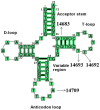The Association Between Mitochondrial tRNAGlu Variants and Hearing Loss: A Case-Control Study
- PMID: 38562431
- PMCID: PMC10984097
- DOI: 10.2147/PGPM.S441281
The Association Between Mitochondrial tRNAGlu Variants and Hearing Loss: A Case-Control Study
Abstract
Purpose: This study aimed to examine the frequencies of mt-tRNAGlu variants in 180 pediatric patients with non-syndromic hearing loss (NSHL) and 100 controls.
Methods: Sanger sequencing was performed to screen for mt-tRNAGlu variants. These mitochondrial DNA (mtDNA) pathogenic mutations were further assessed using phylogenetic conservation and haplogroup analyses. We also traced the origins of the family history of probands carrying potential pathogenic mtDNA mutations. Mitochondrial functions including mtDNA content, ATP and reactive oxygen species (ROS) were examined in cells derived from patients carrying the mt-tRNAGlu A14692G and CO1/tRNASer(UCN) G7444A variants and controls.
Results: We identified four possible pathogenic variants: m.T14709C, m.A14683G, m.A14692G and m.A14693G, which were found in NSHL patients but not in controls. Genetic counseling suggested that one child with the m.A14692G variant had a family history of NSHL. Sequence analysis of mtDNA suggested the presence of the CO1/tRNASer(UCN) G7444A and mt-tRNAGlu A14692G variants. Molecular analysis suggested that, compared with the controls, patients with these variants exhibited much lower mtDNA copy numbers, ATP production, whereas ROS levels increased (p<0.05 for all), suggesting that the m.A14692G and m.G7444A variants led to mitochondrial dysfunction.
Conclusion: mt-tRNAGlu variants are important risk factors for NSHL.
Keywords: deafness; mitochondrial tRNAGlu variants; pediatrics; tRNA metabolism.
Plain language summary
The main aim of our study was to explore the association between the mt-tRNAGlu variants and hearing loss. We found that m.T14709C, m.A14683G, m.A14692G and m.A14693G variants were associated with hearing impairments, these variants localized at extremely conserved nucleotides of mt-tRNAGlu and may result a failure in tRNA metabolism, furthermore, patients with mt-tRNAGlu variants exhibited much lower levels of mtDNA copy number, ATP as compared with controls, whereas ROS increased. As a result, mt-tRNAGlu variants may serve as biomarkers for mitochondrial deafness, and screening for tRNAGlu variants is recommended for early detection and diagnosis of mitochondrial deafness.
© 2024 Yu et al.
Conflict of interest statement
The authors declare that they have no competing interests in this work.
Figures








Similar articles
-
Screening of mitochondrial tRNA mutations in 300 infants with hearing loss.Mitochondrial DNA A DNA Mapp Seq Anal. 2019 Mar;30(2):345-350. doi: 10.1080/24701394.2018.1527910. Epub 2018 Nov 19. Mitochondrial DNA A DNA Mapp Seq Anal. 2019. PMID: 30451057
-
Maternally Inherited Essential Hypertension May Be Associated with the Mutations in Mitochondrial tRNAGlu Gene.Pharmgenomics Pers Med. 2024 Jan 9;17:13-26. doi: 10.2147/PGPM.S436235. eCollection 2024. Pharmgenomics Pers Med. 2024. PMID: 38222291 Free PMC article.
-
Maternally transmitted nonsyndromic hearing impairment may be associated with mitochondrial tRNAAla 5601C>T and tRNALeu(CUN) 12311T>C mutations.J Clin Lab Anal. 2022 Apr;36(4):e24298. doi: 10.1002/jcla.24298. Epub 2022 Feb 26. J Clin Lab Anal. 2022. PMID: 35218233 Free PMC article.
-
[Mutations of mitochondrial tRNASer(UCN) and their connection with hearing loss].Zhonghua Yi Xue Yi Chuan Xue Za Zhi. 2017 Feb 10;34(1):128-132. doi: 10.3760/cma.j.issn.1003-9406.2017.01.030. Zhonghua Yi Xue Yi Chuan Xue Za Zhi. 2017. PMID: 28186612 Review. Chinese.
-
[Mitochondrial DNA mutations and aminoglycoside antibiotics and hearing loss].Lin Chuang Er Bi Yan Hou Tou Jing Wai Ke Za Zhi. 2015 Nov;29(22):1936-40. Lin Chuang Er Bi Yan Hou Tou Jing Wai Ke Za Zhi. 2015. PMID: 26911053 Review. Chinese.
Cited by
-
Mitochondrial tRNAGlu 14687A>G May Be A Novel Mutation for Type 2 Diabetes Mellitus.J Clin Lab Anal. 2025 Jul;39(13):e70056. doi: 10.1002/jcla.70056. Epub 2025 Jun 12. J Clin Lab Anal. 2025. PMID: 40503657 Free PMC article.
-
Mitochondrial DNA variation and intervertebral disc degeneration: a genotypic analysis in a South African cohort.Mol Biol Rep. 2025 Mar 7;52(1):288. doi: 10.1007/s11033-025-10394-6. Mol Biol Rep. 2025. PMID: 40053230 Free PMC article.
References
-
- Marinelli JP, Lohse CM, Fussell WL, et al. Association between hearing loss and development of dementia using formal behavioural audiometric testing within the Mayo Clinic Study of Aging (MCSA): a prospective population-based study. Lancet Healthy Longev. 2022;3(12):e817–e824. doi:10.1016/S2666-7568(22)00241-0 - DOI - PMC - PubMed
LinkOut - more resources
Full Text Sources
Research Materials

